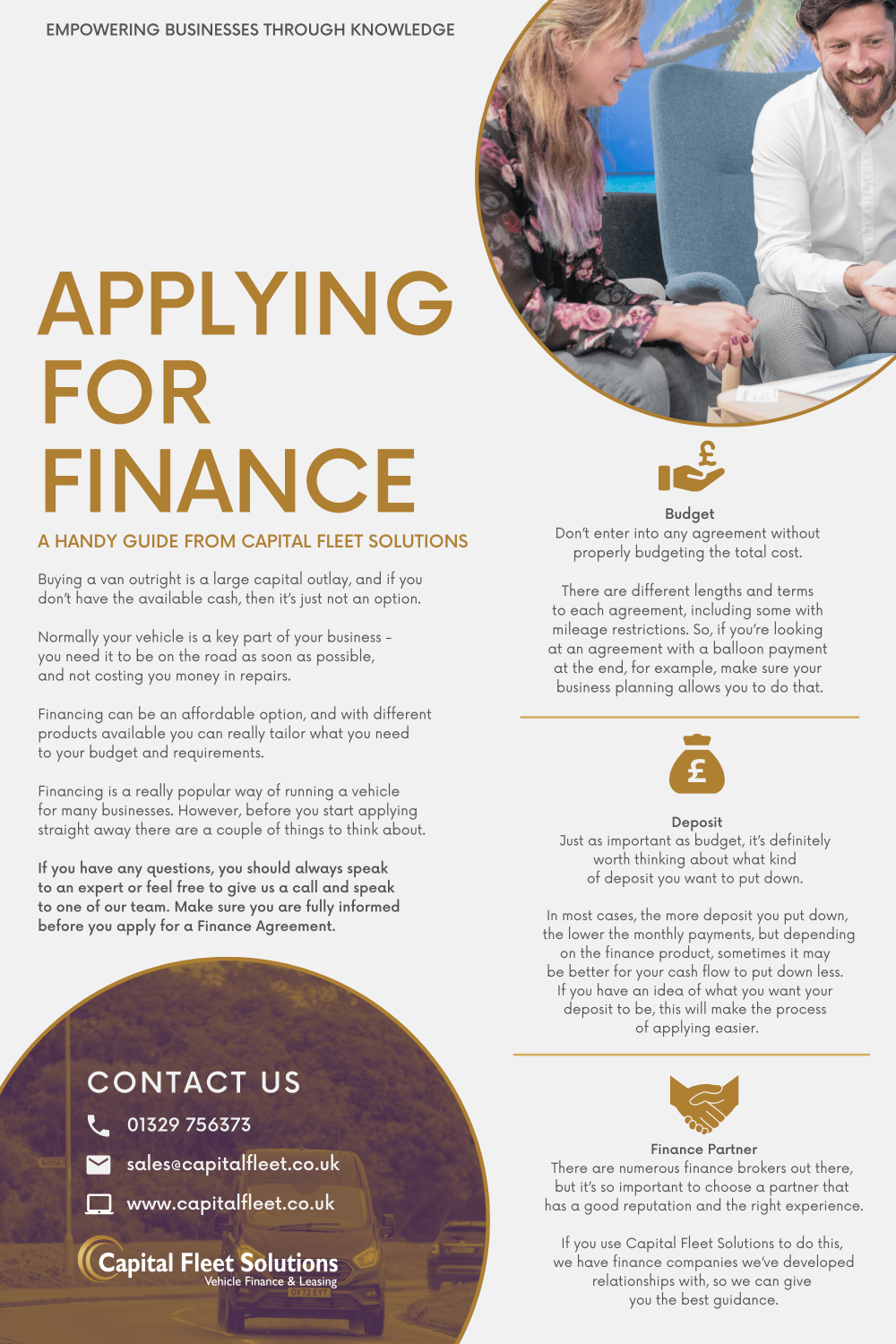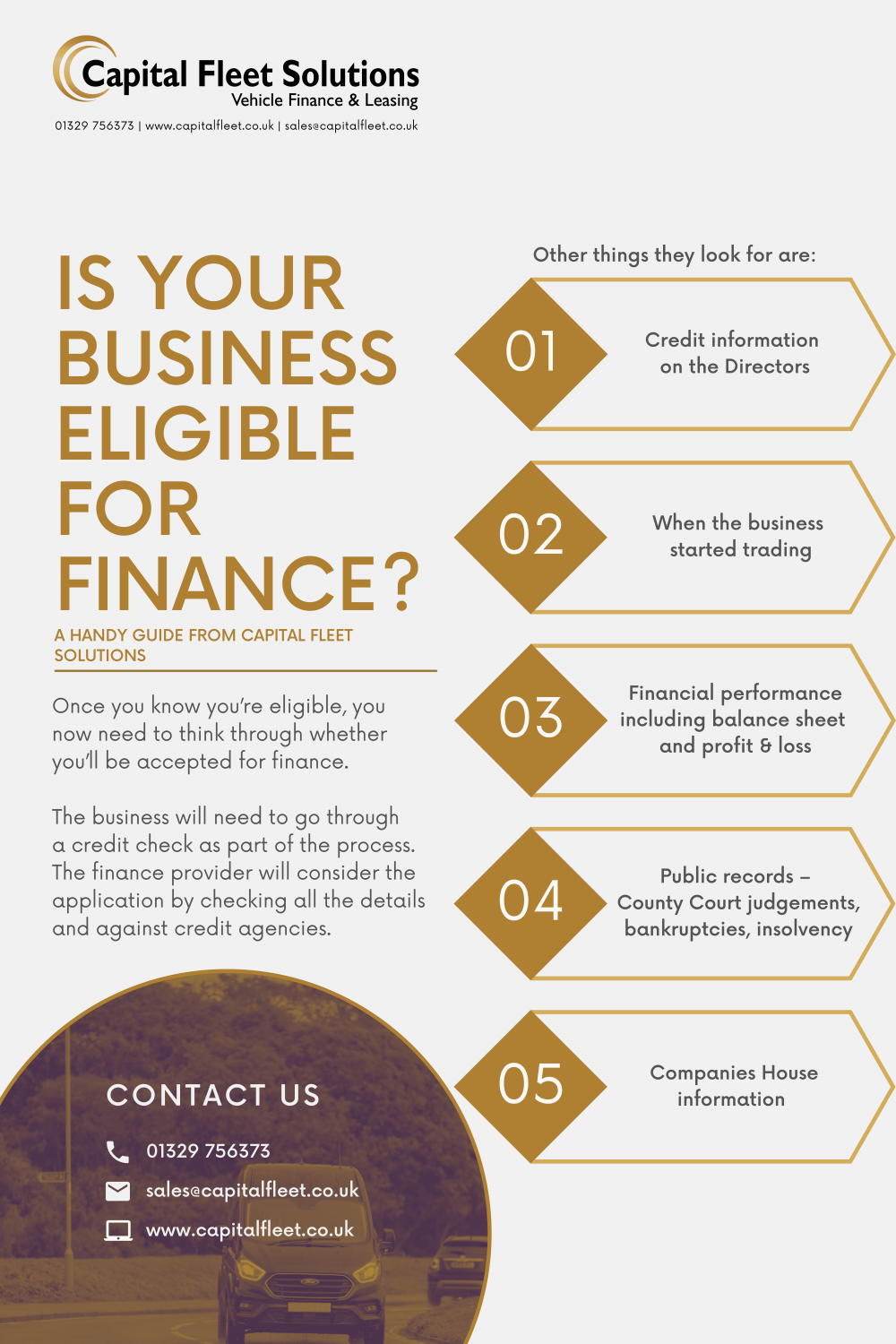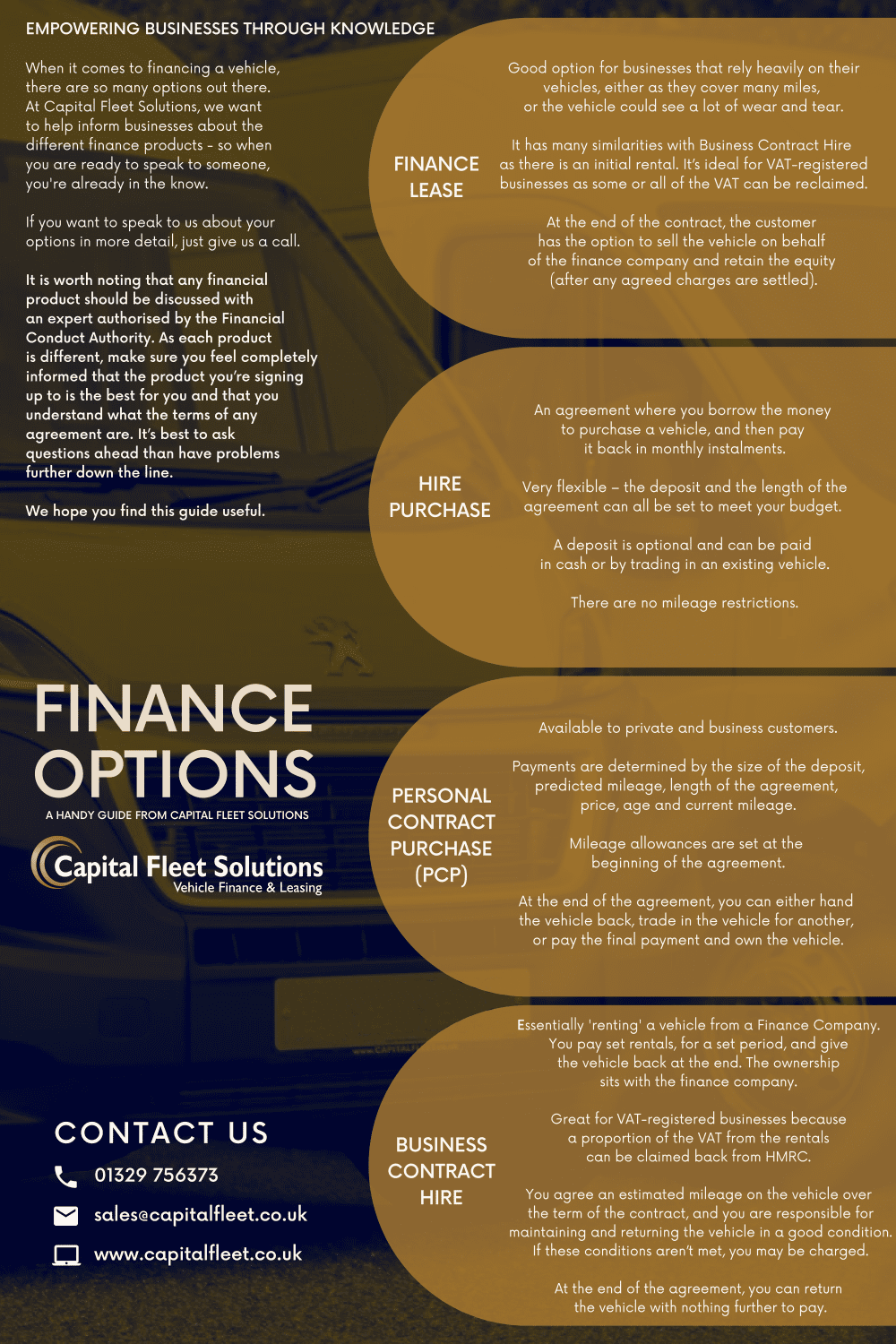All about BUSINESS finance
Advice You Can Trust
At Capital Fleet Solutions, we are passionate about empowering businesses with a deep understanding of business finance.
Mastering business finance is essential for every company, regardless of size or industry, because it empowers informed decision-making, fuels sustainable growth, and helps navigate today’s complex market landscape with confidence. At Capital Fleet Solutions, we don’t stop at simply providing vehicles; instead, we actively equip our clients with practical financial insights and powerful tools. By doing so, we enable them to optimise cash flow, manage budgets efficiently, and plan strategically for long-term success. This hands-on approach ensures businesses stay financially agile and well-prepared for whatever challenges lie ahead.
FINANCE PRODUCTS
Hire Purchase
Technically 'loaning' the vehicle, then paying it back. Flexible to suit budgets
Finance Lease
A flexible option which gives you the use, but not ownership of the vehicle
Lease Purchase
Contract Hire
Essentially 'renting' a vehicle. Set monthly fee for an agreed period and mileage allowance
Contract Purchase
Personal Contract Purchase (PCP)
Similar to Hire Purchase, but monthly payments paying off the depreciation of the vehicle, so a balloon payment is needed at the end to keep the vehicle
What's Involved In Applying For Vehicle Finance?
Want to find out more about business finance?
Finance Guides
Empowering You Through Knowledge
Is Your Business Eligible For Finance?
Key steps
Key Questions To Ask When Considering Financing A Vehicle
1. Decide on your vehicle
2. Select your finance product
3. Get credit approval
4. Sign your documents
5. Recieve your vehicle
1. Decide on your vehicle
Business suitability:
To begin with, choose a vehicle that directly supports your operational needs – whether that’s payload capacity, fuel type, or onboard tech. Additionally, consider how the vehicle complements your brand image, especially if it will be customer-facing. Ultimately, the right choice should enhance both functionality and professionalism.
Cost analysis:
Next, take a close look at the total cost of ownership. This includes not only the purchase price but also ongoing expenses such as maintenance, insurance premiums, and fuel efficiency. By evaluating these factors upfront, you can avoid unexpected costs and ensure long-term affordability.
VAT & tax implications:
Consider whether the vehicle qualifies for VAT reclaim and capital allowances.
2. Select your finance product
Finance Product:
- First, carefully consider the type of finance that best suits your business needs and cash flow preferences. Whether it’s Hire Purchase, Lease, or Contract Hire, each option offers different benefits and commitments.
Ownership:
- Next, reflect on ownership – decide if you want to own the vehicle outright or prefer the flexibility to own it at the end of the contract.
VAT:
- Are you VAT registered?
3. Get credit approval
Affordability checks:
- Lenders must assess your business’s ability to repay, using financial statements and credit history.
- It’s important you keep the vehicle well maintained and adherence to the manufacturer’s recommendations with respect to service intervals, daily checks and such. This will help ensure compliance and operational safety as well lowering operating costs and the likelihood of incurring vehicle return costs. Paperwork will be provided at the start of the contract to help you with this aspect
- If the vehicle/associated equipment is neglected or damaged during the lease term and this is not rectified before the vehicle is sold, you will incur charges from the leasing company. However, you can rectify this by arranging to repair the damage, prior to return. This must be completed to a professional standard by a professional with a transferrable warranty
4. Sign your documents
Contract clarity:
Understand terms including early settlement, mileage limits (if leasing), and end-of-term obligations.
5. Recieve your vehicle
Ongoing obligations:
- Maintain payments, insurance, and servicing as per contract—especially important for lease or hire agreements.

fair wear and tear
The following is a summary of the BVRLA Fair Wear & Tear guidelines. A complete version can be requested from your leasing company.

Wheels, Trims and Tyres
ACCEPTABLE
- One scratch on the border of the wheel rim measuring under 100mm
- One scuff on the border of the wheel rim measuring under 100mm
- Scuffs/scratches on the face of the wheel trim measuring under 100mm
- Tyres with a legal minimal tread of 1.6mm
NOT ACCEPTABLE
- Any abrasion, scratch or scuff measuring over 100mm
- Any bulges, cracks or cuts on a tyre
- Any deformity of the wheel: cap, tyre, rim, trim or alloy
- Any tyre with a tread under the legal limit of 1.6mm
External Mirrors, Light and Windows
ACCEPTABLE
- Any stone chip to the surface of the light casings that has not caused a break
- Any abrasions, scratches or scuffing, or up to 50mm on mirror casing
- Any windscreen stone chip, under 10mm, that is not in the driver’s line of sight
NOT ACCEPTABLE
- Any chip or crack which is larger than 1cm regardless of its location
- Any deformation of the mirror/mirror case
- Broken glass or non-operational lights
Interior
ACCEPTABLE
- Any phone fixings that have be added can be left provided they are fitted correctly
- Deterioration of the seats caused by normal usage
- Any stains that can be successfully removed by general cleaning
- Discolouration caused by day to day usage
NOT ACCEPTABLE
- Unpleasant odours or soiling that is not likely to be removed via general cleaning
- Any abrasion, cut, tear or deformation of interior materials (e.g. carpets, seats and floor mats)
- Any gaps, holes or spaces left from the removal of equipment
- Any missing fixtures
Loading Area, Sills and Seals
ACCEPTABLE
- Any scuff or scratch of the loading area sills and seals that will not be seen from the outside and does not interfere with the function of the doors
- Any deformation of the loading area sills and seals that will not be seen from the outside and does not interfere with the function of the doors
- Any bump of the loading area sills and seals that will not be seen from the outside and does not interfere with the function of the doors
- Any dent of the loading area sills and seals that will not be seen from the outside and does not interfere with the function of the doors
- Any additional fittings can be left on the vehicle provided they have been fitted correctly
NOT ACCEPTABLE
- Any damage to the interior lining that impacts upon the use of windows, doors or any other fitting
- Any deformation, scratch or scuff of the loading area sills and seals, that will not be seen from the outside, and does not interfere with the function of the doors
- Any holes in the loading floor
- Any corrosion
- Any lining that is missing, ripped or torn
- Any large abrasions or dents caused by improper loading or poorly secured goods
Vehicle Exterior
ACCEPTABLE
- Small scratches measuring up to 100mm that could be removed with polishing
- Any dent measuring less than 20mm and only 2 dents per panel
- Any bump measuring less than 20mm and only 2 bumps per panel
- Any scratch up to 100mm on any non-painted or textured bumpers
- Any scuff up to 100mm on any non-painted or textured bumpers
- Discolouration that is due to normal external factors
NOT ACCEPTABLE
- Stickers and/or any glue residue from stickers
- Paint discolouration resulting from unnatural means (e.g., chemicals)
- Any detectable repair
- Breaks or cracks in a bumper or grilles
- Corrosion (e.g., rust)
- Any abrasion, scratch or scuff over 100mm which cannot be polished out
- Any dent over 20mm




